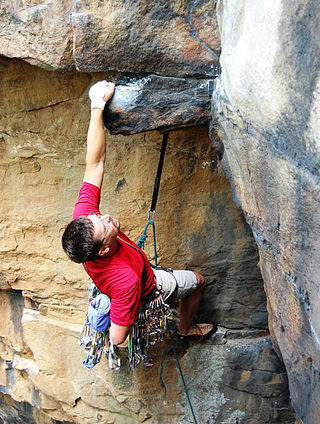
Traditional climbing is a type of free climbing in rock climbing where the lead climber places the protection equipment while ascending the route; when the lead climber has completed the route, the second climber then removes the protection equipment as they climb the route. Traditional climbing differs from sport climbing where the protection equipment is pre-drilled into the rock in the form of bolts.
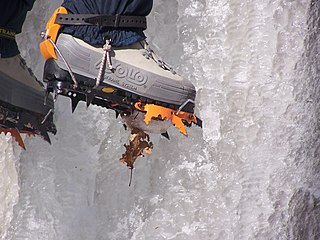
A crampon is a traction device attached to footwear to improve mobility on snow and ice during ice climbing. Besides ice climbing, crampons are also used for secure travel on snow and ice, such as crossing glaciers, snowfields and icefields, ascending snow slopes, and scaling ice-covered rock.

Glossary of climbing terms relates to rock climbing, mountaineering, and to ice climbing.

Rock-climbing equipment varies with the type of climbing undertaken. Bouldering needs the least equipment outside of shoes and chalk and optional crash pads. Sport climbing adds ropes, harnesses, belay devices, and quickdraws to clip into pre-drilled bolts. Traditional climbing adds the need for carrying a "rack" of temporary passive and active protection devices. Multi-pitch climbing adds devices to assist in ascending and descending fixed ropes. And finally aid climbing uses unique equipment.
Self-locking devices are devices intended to arrest the fall of solo climbers who climb without partners. This device is used for rope solo climbing, for "ground-up climbing", and for "top rope solo climbing". To date, several types of self-locking devices have evolved.

Belaying is a variety of techniques climbers use to create friction within a climbing system, particularly on a climbing rope, so that a falling climber does not fall very far. A climbing partner typically applies tension at the other end of the rope whenever the climber is not moving, and removes the tension from the rope whenever the climber needs more rope to continue climbing.

In rock climbing, a nut is a metal wedge threaded on a wire that climbers use for protection by wedging it into a crack in the rock. Quickdraws are clipped to the nut wire by the ascending climber and the rope threads through the quickdraw. Nuts come in a variety of sizes and styles, and several different brands are made by competing manufacturers. Most nuts are made of aluminum. Larger nuts may be threaded on Dyneema cord instead of wire, but this has become unusual.
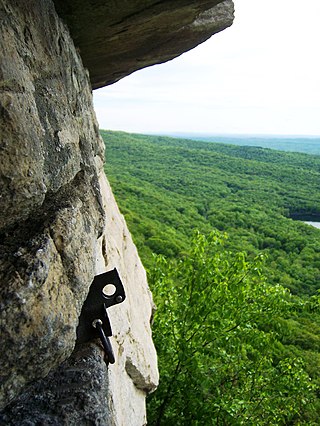
Clean climbing is rock climbing techniques and equipment which climbers use in order to avoid damage to the rock. These techniques date at least in part from the 1920s and earlier in England, but the term itself may have emerged in about 1970 during the widespread and rapid adoption in the United States and Canada of nuts, and the very similar but often larger hexes, in preference to pitons, which damage rock and are more difficult and time-consuming to install. Pitons were thus eliminated in North America as a primary means of climbing protection in a period of less than three years.

A piton in big wall climbing and in aid climbing is a metal spike that is driven into a crack or seam in the climbing surface using a climbing hammer, and which acts as an anchor for protecting the climber from falling or to assist progress in aid climbing. Pitons are equipped with an eye hole or a ring to which a carabiner is attached; the carabiner can then be directly or indirectly connected to a climbing rope.

Rock climbing is a sport in which participants climb up, across, or down natural rock formations or indoor climbing walls. The goal is to reach the summit of a formation or the endpoint of a usually pre-defined route without falling. Rock climbing is a physically and mentally demanding sport, one that often tests a climber's strength, endurance, agility and balance along with mental control. Knowledge of proper climbing techniques and the use of specialized climbing equipment is crucial for the safe completion of routes.

A Prusik is a friction hitch or knot used to attach a loop of cord around a rope, applied in climbing, canyoneering, mountaineering, caving, rope rescue, ziplining, and by arborists. The term Prusik is a name for both the loops of cord used to tie the hitch and the hitch itself, and the verb is "to prusik" or "prusiking". More casually, the term is used for any friction hitch or device that can grab a rope. Due to the pronunciation, the word is often misspelled Prussik, Prussick, or Prussic.
In rock climbing, an anchor can be any device or method for attaching a climber, a rope, or a load above or onto a climbing surface—typically rock, ice, steep dirt, or a building—either permanently or temporarily. The intention of an anchor is case-specific but is usually for fall protection, primarily fall arrest and fall restraint. Climbing anchors are also used for hoisting, holding static loads, or redirecting a rope.

A belay device is a mechanical piece of climbing equipment used to control a rope during belaying. It is designed to improve belay safety for the climber by allowing the belayer to manage their duties with minimal physical effort. With the right belay device, a small, weak climber can easily arrest the fall of a much heavier partner. Belay devices act as a friction brake, so that when a climber falls with any slack in the rope, the fall is brought to a stop.
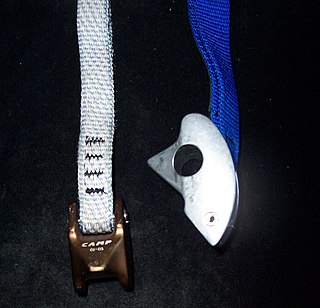
A tricam is a type of climbing protection equipment. A versatile nut/cam hybrid, the Tricam was invented by Greg Lowe in 1973, and came to market in 1981. They are currently manufactured by C.A.M.P. of Premana Italy.
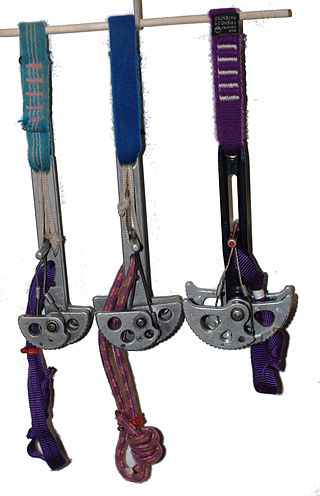
Wild Country is a major manufacturer of rock-climbing equipment, and is most noted for introducing the Friend, a spring-loaded camming device. The company is based in Tideswell in the English Peak District, close to some of the UK's most popular climbing areas.
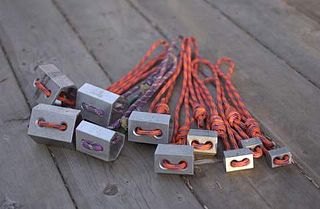
A hex is an item of rock-climbing equipment used to protect climbers from falls. They are intended to be wedged into a crack or other opening in the rock, and do not require a hammer to place. They were developed as an alternative to pitons, which are hammered into cracks, damaging the rock. Most commonly, a carabiner will be used to join the hex to the climbing rope by means of a loop of webbing, cord or a cable which is part of the hex.

The Abalakov thread, also known as a V-thread, A-thread, or 0-thread, is an ice protection technique named after its inventor, Soviet climber Vitaly Abalakov. The Abalakov thread is a common method of protecting oneself while ice climbing because it is easy to create, does not require the sacrifice of expensive gear, and can be very safe when used properly. An Abalakov thread is often used in multi-pitch ice climbing routes. Because of its safety and convenience, the Abalakov thread is considered one of the most significant innovations in ice climbing. It significantly expanded the scope of possible routes and abseiling safety.

Camalot is a brand of spring-loaded camming devices manufactured by Black Diamond Equipment used to secure ropes while rock climbing. Camalots use a dual-axle system, resulting in a slightly higher expansion range than similarly sized single axle units, however that results in significant weight penalty. Dual-axle was patented and for decades was only used by Black Diamond, however the patent has expired in 2005 and several other manufacturers began producing dual-axel cams, often also replicating Camalots sizes and coloring. Most notable Camalot look-alikes include DMM Dragons and Wild Country's New Friends.

Crack climbing is a type of rock climbing in which the climber follows a crack in the rock and uses specialized climbing techniques. The sizes of cracks vary from those that are just barely wide enough for the fingers to fit inside, to those that are so wide that the entire body can fit inside with all limbs outstretched. Many traditional climbing routes follow crack systems, as they provide natural opportunities for placing protective equipment.

Mark Vallance was a British rock climber, mountaineer and founder of Wild Country, a climbing equipment company.




















